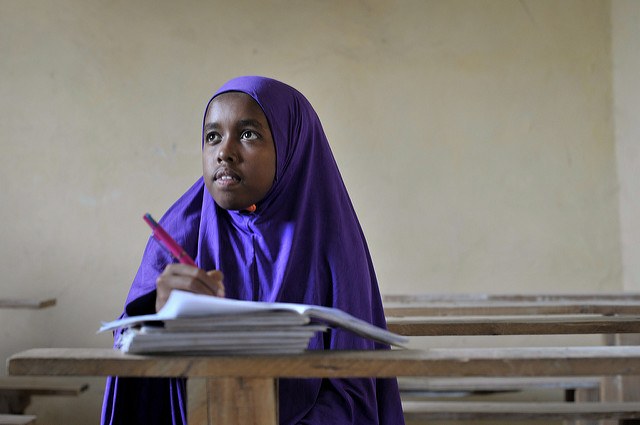10 Important Facts About Girls’ Education in Somalia
 The East African country of Somalia has been ravaged by famine and war, leaving a large majority of the population in poverty. In addition, education opportunities for many Somali children are somewhat limited, especially for girls. Education and equal opportunities are important for improving the quality of life. Below are 10 highly important facts about girls’ education in Somalia.
The East African country of Somalia has been ravaged by famine and war, leaving a large majority of the population in poverty. In addition, education opportunities for many Somali children are somewhat limited, especially for girls. Education and equal opportunities are important for improving the quality of life. Below are 10 highly important facts about girls’ education in Somalia.
10 Facts About Girls’ Education in Somalia
- Over 70 percent of Somalia’s population is under the age of 30, with slightly more males than females. Somalia’s large percentage of youth indicates a need for economic growth in a country with an unemployment rate of 67 percent. In order to ensure a higher living standard and an improved economy as Somali youth mature, education is a key factor for Somalia.
- Although education problems exist in both rural and urban areas of Somalia, access to education in rural regions is even more limited. Nomadic pastoralists account for about 65 percent of the Somali population, and only 22 percent of pastoralist children receive a formal education. Of the 22 percent that receive a formal education, fewer than half are girls.
- Low enrollment rates in schools are apparent throughout the country, and girls’ enrollment rates are significantly lower, indicating why these facts about girls’ education in Somalia are so important. Somalia has one of the world’s lowest enrollment rates for primary schools. Only 30 percent of children in Somalia are in school and only 40 percent of those children are girls.
- One of the biggest reasons for a disparity in girls’ education is due to the act of female genital mutilation, or FGM. According to UNICEF, about 98 percent of Somali girls have undergone a form of FGM. These acts are often performed in unhygienic conditions by surgeons who have no training. After a girl undergoes FGM, the aftereffects of debilitating scarring and infections–along with the possibility of marriage–results in the withdrawal of thousands of girls from school.
- Girls in Somalia are often wed at young ages, ending their education enrollment. According to UNICEF, 45 percent of girls were already married by age 18 in 2017. Through education initiatives, however, more daughters are able to stay in school.
- Somali girls are also subject to gender expectations that keep them from receiving an education. Girls often stay home and complete domestic housework or help raise younger children.
- The majority of female jobs, particularly in the rural south of Somalia, are jobs that do not require an education. These jobs–which include tending to livestock, milking animals, home care and farming–discourage parents from allowing their children to receive a formal education. Somalia’s high poverty rates and economic challenges could be aided with formal education for girls and boys and could shift the rate of unskilled labor in the country. Receiving an education would be essential and beneficial for these children.
- Literacy rates in Somalia are unevenly distributed between boys and girls. The total literacy rate is 37.8 percent in the African nation. Men have a literacy rate of 49.7 percent, while only 25.8 percent of females are literate, highlighting the true educational gender inequality in Somalia.
- Girls’ education in Somalia has been the subject of organizations like UNICEF, which strives to improve access to and the quality of girls’ education in the country. Due to political instability, however, UNICEF Somalia has only operated in the autonomous region of Puntland and the de facto independent Somaliland. In Puntland, UNICEF has established four girls’ leadership committees in schools and plans are underway to train 40 female teachers through Garowe Teachers’ College. In addition, 12 trained female teachers were recruited to be part of the Somaliland Ministry of Education teaching force.
- The Galkacyo Education Center for Peace and Development was established in 1999 as a response to gender inequality in the Somali education system and operates in Somalia proper and Puntland to increase educational access for girls. Since its foundation, the organization has provided primary schooling to 800 girls–over half of which completed grade eight–and informal education to 1,600 adolescent women.
The inequality between boys’ and girls’ education is apparent with these 10 facts about girls’ education in Somalia. Economic issues, political instability, in addition to traditions like FGM and required housework, have restricted girls’ access to a formal education. Despite these problems, there are organizations and centers that aim to educate more girls in the country and the work must continue to grow. In order for the young Somali population to have better opportunities in the future, equal gender opportunities to education in the country are vital.
– Matthew Cline
Photo: Flickr
